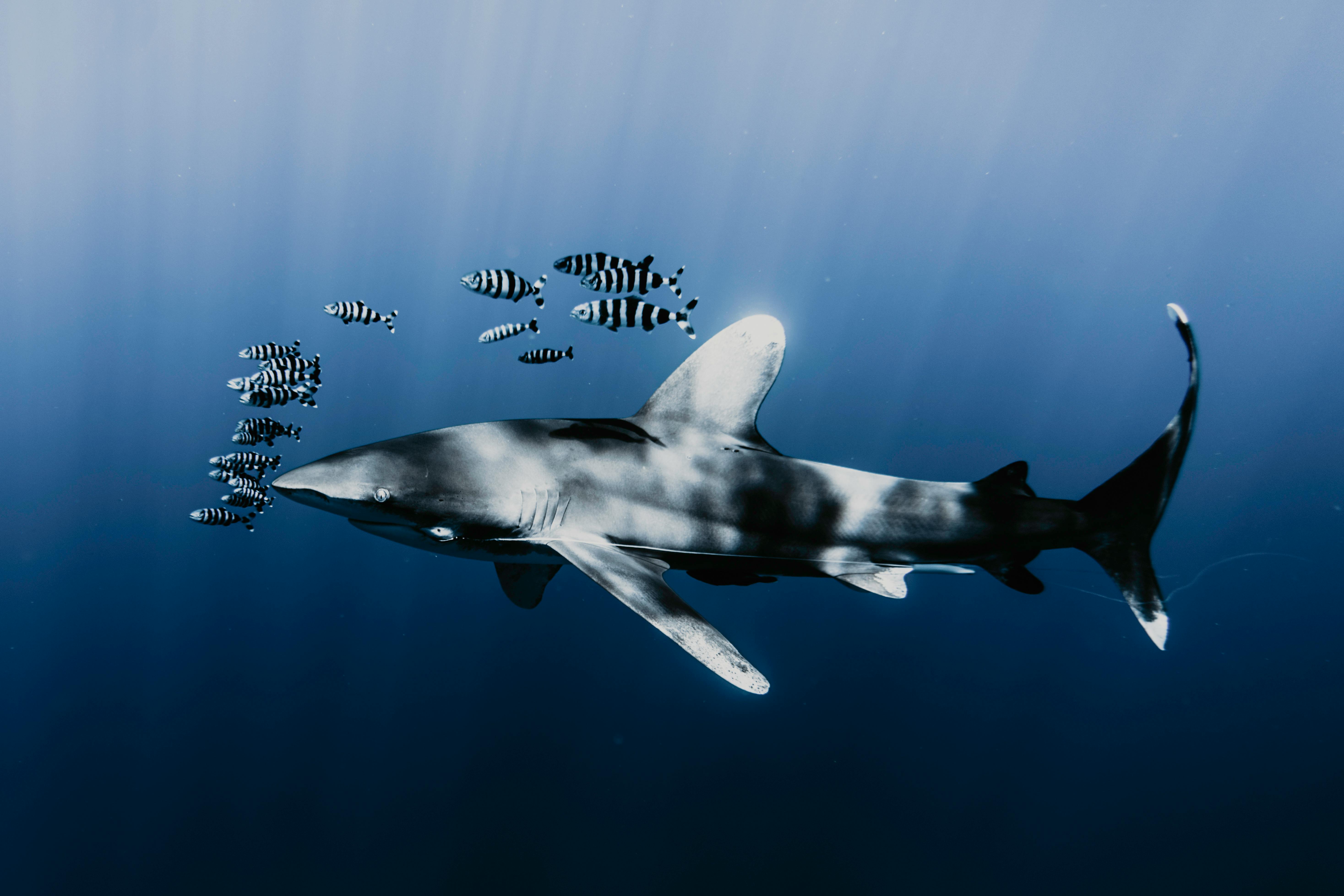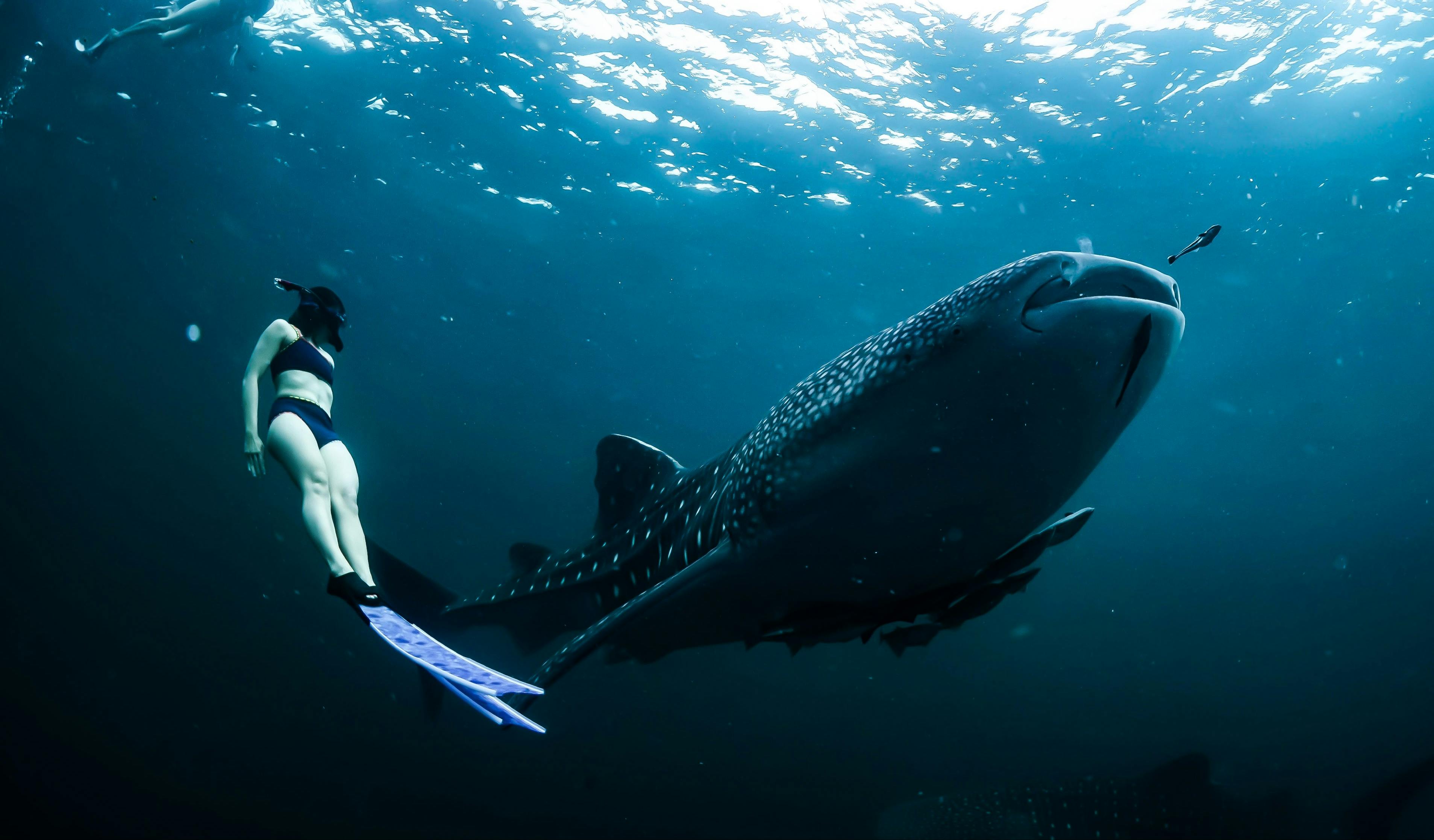Spinner Sharks are a species of requiem shark found in tropical and subtropical waters throughout the world. They are named for their habit of leaping out of the water and spinning in midair, a behavior known as “spinning”. These small sharks typically reach a maximum length of around 6.5 feet (2 meters) and weigh up to 200 pounds (90 kg). Spinner Sharks feed on small fish, squid, and crustaceans, using their sharp teeth to capture their prey. They are also known to follow schools of fish in the water. Despite their small size, Spinner Sharks are considered potentially dangerous due to their large mouths and sharp teeth.A Spinner Shark is a species of requiem shark, known for its acrobatic displays of spinning as it leaps out of the water while feeding. It is a small to medium-sized species, growing to an average length of 2.1 m (6.9 ft). It has a slim body and long snout, and its back and sides are gray with a white underside. The Spinner Shark tends to inhabit warm, coastal waters in the Atlantic, Pacific and Indian Oceans.
Contents
What Does a Spinner Shark Look Like?
The spinner shark is a slender, medium-sized shark with a pointed snout and large eyes. It has a long, cylindrical body and can grow up to 6.5 feet in length. The spinner shark’s top fin is taller than its bottom one and they have long, narrow pectoral fins that can span up to 1.9 feet in length. Its coloring is usually gray or bluish-gray on the top and white on the underside, with some blackish spots along the sides of its body. The spinner shark has several rows of small, sharp teeth, which it uses to feed on small fish, squid and crustaceans.
The spinner shark is named for its unique swimming style: it propels itself forward by spinning its body around in circles like a spinning top. This allows it to move quickly through the water while searching for food. The spinner shark is also known for its acrobatic leaps out of the water when it is disturbed or hunting prey. It can leap as high as 10 feet out of the water!
Overall, the spinner shark is an impressive species of shark with an equally impressive swimming style that makes it stand out from other types of sharks. Its sleek body shape and coloration make it perfect for blending into its environment while hunting prey.
Where Do Spinner Sharks Live?
Spinner sharks are found mainly in tropical and subtropical waters around the world, from South Africa to Hawaii. They prefer coastal areas, typically near coral reefs and other shallow coastal habitats such as lagoons, bays and estuaries. Spinner sharks can also be found in deep open waters, but only during migrations.
Spinner sharks are commonly observed in the Gulf of Mexico, the Caribbean Sea and off the coast of South America. They have also been sighted in various parts of Australia and Southeast Asia. Spinner sharks often move northward to warmer waters during winter months, while they migrate southward during summer months.
Spinner sharks tend to inhabit continental shelves, ranging up to depths of 600 feet (183 meters). They spend most of their time near the surface searching for prey such as fish or squid. When hunting for prey at night, spinner sharks will swim rapidly above the surface in a spinning motion to confuse their prey with their silhouette.
Spinner sharks are also found along the eastern seaboard of North America from Florida to Massachusetts during summer months when they migrate northward. During winter months they migrate southward along the same route. In addition, they can be found in Hawaiian waters year-round.
In general, spinner shark populations appear to be healthy throughout their range; however, they are highly sought after by commercial fisheries due to their high-quality meat and fins which are used for soup and shark fin soup respectively. As a result, fishermen often target them which can lead to localized depletion of spinner shark populations if not managed properly.
How Big Are Spinner Sharks?
Spinner sharks are a species of coastal shark found in tropical and warm temperate waters of the Atlantic, Pacific, and Indian Oceans. They are one of the smaller species of shark, reaching an average size of 8 feet (2.4 m). The maximum recorded length for a spinner shark is 10 feet (3 m). They are slender with a cylindrical body shape and can be identified by their long, pointed snout and slim tail.
Spinner sharks have a dark gray or bronze color on the dorsal side which fades to a white ventral side. Juveniles have distinctive stripes along their sides which helps distinguish them from other types of sharks. The most distinctive feature on adult spinner sharks is their long pectoral fins which can reach up to 3 feet (0.9 m) in length.
Spinner sharks are relatively small compared to other species of shark. They typically weigh less than 200 lbs (90 kg), making them one of the smallest species of coastal shark in the world. Despite their small size, they are still considered potentially dangerous animals due to their large pectoral fins and powerful jaws which can inflict serious injury if provoked or threatened.
What Do Spinner Sharks Eat?
Spinner sharks are known for their diverse diet that consists of a variety of fish species. They feed on small schooling fish such as anchovies, sardines, herring, mackerel, mullet, and other small fish. They also feed on octopus, squid and crustaceans. Spinner sharks have been observed feeding close to the surface in large numbers, with individuals exhibiting cooperative behavior when hunting. These sharks have even been known to follow fishing vessels in order to take advantage of the disturbed prey that are attracted to the boats.
In addition to their varied diet of fish and invertebrates, spinner sharks may also feed on sea turtles and occasionally birds. They have been known to circle schools of prey in order to herd them together before attacking them en masse. This type of behavior is common among larger predatory sharks such as tiger sharks and great white sharks. In some cases, spinner sharks will actively hunt down large prey items such as sea turtles or dolphins in order to satisfy their large appetites.
Overall, spinner sharks are opportunistic predators that take advantage of whatever food sources are available in their environment. Their diets can vary greatly based upon their location and seasonality as they migrate throughout the world’s oceans in search of abundant prey sources.

How Do Spinner Sharks Reproduce?
Spinner sharks reproduce by the process of aplacental viviparity, which is also known as ovoviviparity. In this method, the female shark will store the sperm of the male in her reproductive tract, and the eggs will hatch within her body. The embryos are then nourished by their yolk sacs until they are ready to be born. The gestation period for spinner sharks is approximately 10-11 months. The litter size is usually small, ranging from 1-7 pups. The newborns are usually between 17-30 inches long at birth and weigh around 0.5-1 pound. Once born, the pups remain in shallow waters close to shore where they can find protection from predators.
Newborn spinner sharks feed mainly on small fish and shrimp until they are large enough to venture out into deeper waters. As they grow, they become more independent and start migrating to different areas in search of food and mates. Adult spinner sharks are migratory species that can cover large distances during their lifetime. They have been recorded traveling up to 3,000 miles in search of prey and mates.
Are Spinner Sharks Endangered?
Spinner sharks (Carcharhinus brevipinna) are listed as ‘Near Threatened’ on the International Union for Conservation of Nature (IUCN) Red List of Threatened Species. They are found in tropical and subtropical waters worldwide, but most abundant in the western Atlantic Ocean. Spinner sharks are a highly migratory species and often travel long distances to feed and reproduce, making them vulnerable to overfishing.
The primary threats to spinner sharks include bycatch in commercial and recreational fisheries, habitat degradation, and climate change. Spinner sharks are sometimes caught unintentionally during fishing activities due to their schooling behavior, which increases their vulnerability to entanglement in nets or lines. Additionally, they are often targeted for their meat, fins, and oil. Habitat degradation due to pollution and coastal development can also impact spinner shark populations. Finally, climate change is likely to have an effect on the availability of prey species that spinner sharks rely on for food.
In order to reduce threats to spinner shark populations, it is important that fisheries regulations are properly enforced and that measures are taken to reduce bycatch. Additionally, conservation efforts should focus on protecting important habitats such as nursery areas or spawning grounds. Finally, it is essential that we continue to monitor the status of spinner shark populations in order to ensure they remain healthy and viable into the future.
Overall, while spinner sharks are not currently endangered or critically endangered, they still face numerous threats which could lead them towards extinction if not adequately addressed in a timely manner.
Threats to Spinner Sharks
Spinner sharks are one of the most vulnerable species to human impacts. They are especially susceptible to overfishing and bycatch, where they are unintentionally caught and killed in fishing nets. Illegal, unregulated and unreported fishing practices also pose a serious threat to spinner sharks, as it is difficult for authorities to monitor and regulate such activities. The destruction of their habitat is also a major issue, with coastal development often leading to the destruction of their natural spawning grounds and migration routes. Pollution from various sources is another major threat, with oil spills and chemical runoff poisoning their environment and disrupting their food chains. Climate change is an additional source of danger for spinner sharks, as rising sea temperatures can have a devastating impact on the health of this species.

Conclusion
The Spinner Shark is an incredibly fascinating creature, with its incredible speed, agility and ability to traverse both the water and air. It is also a species that is unfortunately decreasing in numbers due to overfishing and habitat destruction. Consequently, it is important for us to understand the importance of protecting our oceans and its inhabitants in order to ensure the survival of this remarkable species.
In conclusion, the Spinner Shark is a remarkable creature that deserves to be respected and protected for future generations to enjoy. It is up to us to ensure that this species continues to thrive in its natural environment by taking steps towards conserving our oceans.

0 Comments